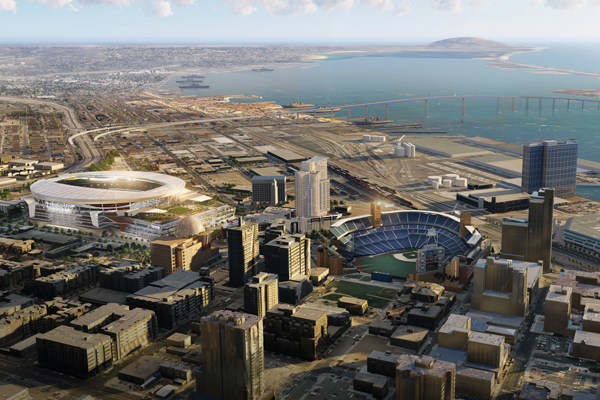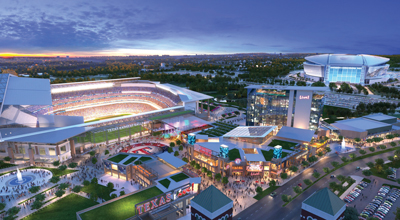 |
The new San Diego football stadium (left in rendering) would sit downtown near Petco Park.
Photo by: MANICA ARCHITECTURE
|
The 2016 presidential campaign has highlighted big differences between candidates Hillary Clinton and Donald Trump. You could say the same about the two major sports facility referendums on the ballot this year.
Voters in Arlington will decide Nov. 8 whether tax dollars, mostly tourism-related, can be used to help finance construction of a new ballpark for the Texas Rangers. Residents of the sports-crazed Lone Star State have a history of approving tax dollars to fund stadium development.
A similar referendum up for a vote that same day in San Diego will decide a similar question regarding a new stadium for the Chargers. There, the team faces an uphill battle, in part because state law requires two-thirds voter approval for tax hikes. A simple majority is required in Arlington.
Taking it to a vote
Results for sports facility funding on the ballot have been mixed in the last 10 years. The most recent new-venue referendum occurred on Long Island, where 56 percent of Nassau County voters rejected a plan to provide $400 million for a new arena for the New York Islanders.
■ Progressive Field (Cleveland Indians)/
FirstEnergy Stadium (Browns)/
Quicken Loans Arena (Cavaliers)
2014: Passed (56%)
Extended for 20 years the county’s “sin tax” (assessed at 4.5 cents per pack of cigarettes, 1.5 cents per 12-ounce bottle of beer, 6 cents per 750-milliliter bottle of wine, 32 cents per gallon of mixed beverages, 24 cents per gallon of cider and $3 per gallon of hard liquor), to help cover costs of renovations
■ Nassau Veterans Memorial Coliseum (New York Islanders)
2011: Defeated (57%)
$400 million to overhaul the arena. The club moved to Brooklyn before the 2015-16 season.
■ Levi’s Stadium (San Francisco 49ers)
2010: Passed (58%)
Santa Clara voters approved $113 million in direct tax subsidies to help fund construction of a new $1 billion stadium for the 49ers, as well as $330 million in subsidies to be paid back from stadium revenue.
■ Chesapeake Energy Arena (Oklahoma City Thunder)
2008: Passed (62%)
1-cent sales tax for $100 million renovation and construction of new $20 million practice facility.
■ Golden 1 Center (Sacramento Kings)
2006: Defeated (80% / 71%)
Separate measures would have raised the local sales tax by a quarter-cent in order to raise $1.2 billion for general fund, and then allocated half of what was raised toward building a new arena. The Kings obtained public money later, and the arena opened this month.
■ Kauffman Stadium (Kansas City Royals)/
Arrowhead Stadium (Chiefs)
2006: Passed (53%) /
Defeated (52%)
A 3/8-cent sales tax raised $256 million for renovations for the Royals and $319 million to update Arrowhead. Voters defeated a separate tax plan that would have funded a $202 million rolling roof to be shared by the venues.
Source: SportsBusiness Journal research
In San Diego, two measures tied to a new stadium are on the ballot, part of the newest chapter in the Chargers’ long-running saga to replace 49-year-old Qualcomm Stadium, the NFL’s second-oldest facility.
Measure C calls for voters to approve an increase in hotel taxes from 12.5 percent to 16.5 percent to help fund a $1.8 billion stadium connected to a convention center complex. Measure D calls for a slightly lower increase, to 15.5 percent.
The Chargers are behind Measure C. To qualify for the November ballot, the team collected 110,000 signatures supporting the proposal.
The measure calls for the Chargers to commit $650 million in financing toward the $1.8 billion facility, split between the team and the NFL. Public financing would come through the increase in hotel taxes.
Considering the Chargers’ failure over the past 15 years to garner public support to build a new stadium in San Diego, as well as the two-thirds approval required in next week’s election, many feel the odds are stacked against Measure C, according to local reports.
Fred Maas, special adviser to team owner Dean Spanos and front man for the team’s political campaign, knows the history. Years ago, as special adviser to former Mayor Jerry Sanders, Maas represented the city on a proposal to build a downtown stadium for the Chargers.
A longtime developer and businessman, Maas knows politics as well. Over the past 35 years, he has worked in campaigns for Bob Dole, John McCain and Jack Kemp.
“We’ve always understood the significant mountain that needs to be climbed to get to a two-thirds vote for anything,” Maas said. “There’s a knee-jerk reaction here any time people hear the word ‘tax,’ so overcoming that and educating folks on what it means … is a challenge. We knew that … and that’s why we structured this [proposal] the way we did.”
The proposed site is next to Petco Park, and the convention center piece brings a multiuse component to the package. The team’s strategy is to combine the two building types to host the Super Bowl, Final Four and X Games, in addition to conventions, and to provide support space on-site for the functions that spin off of those events. The stadium/convention center model is already in place at Lucas Oil Stadium in Indianapolis and University of Phoenix Stadium in Arizona, as well as the dome where the former St. Louis Rams played before moving back to Los Angeles.
“The most important thing for people to understand is that what we’re proposing is way more than a football stadium … all done with a tourist-based tax,” Maas said. “San Diegans, unless they stay in a hotel, will never pay a dime to accomplish it.”
To date, the Chargers have spent about $10 million for the referendum, with half of those expenses invested before Measure C qualified for the ballot, Maas said.
Washington, D.C.-area firms New Troy Strategies, WPA Research and Targeted Victory are among those whom the Chargers have hired to work on the campaign. Chargers quarterback Philip Rivers has been among current and former team stars stumping publicly for the proposal.
San Diego Mayor Kevin Faulconer endorsed Measure C after six months of intense discussions with the Chargers to address uncertainties over funding the project. The same is true for the San Diego Regional Chamber of Commerce and the San Diego Downtown Partnership, a group representing residents and businesses in the 1,500-acre downtown district.
What does it all mean for Measure C? Maybe nothing, considering the major hurdle remains the 67 percent approval required to pass the proposal.
“This year is as crazy a political year as anyone has ever experienced — not just the overlay of the presidential main attraction, but the ballot itself might be the longest ballot I’ve ever experienced,” Maas said. “You’ve got to sift through three pages to get to our measure … it’s chock-full of complexity and confusion. It’s good if we win and bad if we lose.”
A poll by local news organizations released Oct. 21 showed stadium proponents gaining ground from a previous poll but still trailing among likely voters by 4 percentage points, 52 percent to 48 percent. The poll had a margin of error of 4.1 percentage points.
In Arlington, residents will vote to extend sales, hotel and rental car taxes to fund half the total cost to build a $1 billion retractable-roof stadium to replace 22-year-old Globe Life Park.
 |
The Texas Rangers are seeking a new ballpark with a retractable roof in Arlington.
Photo by: COURTESY OF TEXAS RANGERS
|
The Rangers have committed to funding the remaining half of construction after signing a master agreement with the city in May that includes a new lease to replace their current lease, which expires in 2024.
The same half-cent sales tax paid off the city’s debt 10 years early to build the team’s open-air ballpark, which opened in 1994. Down the street, the tax is now being used to pay Arlington’s debt tied to AT&T Stadium, where the Dallas Cowboys have played since 2009.
For the Cowboys’ project, the sales tax is scheduled to pay off debt by 2021, which is 14 years earlier than projected, said Rob Matwick, the Rangers’ executive vice president of business operations.
“The half-cent tax was set to be retired after AT&T Stadium’s debt was retired,” Matwick said. “That’s the crux of the proposition, continuing that tax to allow the funding mechanism for a retractable-roof building here.”
The new stadium would be built in two parking lots south of Globe Life Park. (Separately, The Cordish Cos. is developing Texas Live!, a $250 million entertainment district next to Globe Life Park. The project broke ground in late October, with a portion of retail and restaurants scheduled to open in spring 2018. A hotel is scheduled to open in fall 2018.)
The Rangers feel good about their chances of getting the measure passed and starting the process for ballpark development, Matwick said.
A poll by local media organizations conducted Oct. 11-13 showed voters split, with 42 percent for the measure, 42 percent against and 16 percent undecided. The poll had a margin of error of plus or minus 4.5 percentage points.
But a poll released the same day by a group supporting the project showed the pro-ballpark side with a 19 percentage point advantage.





